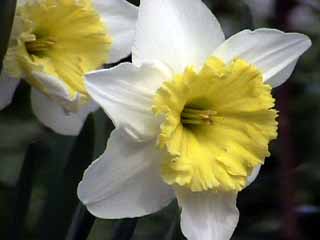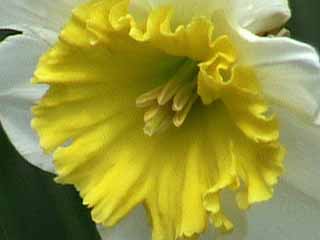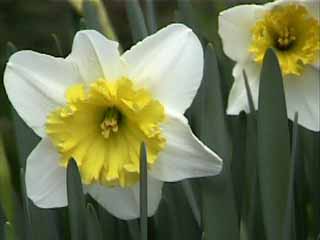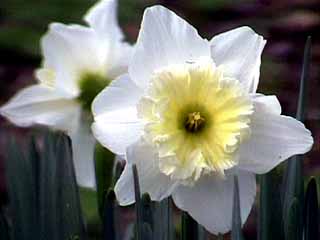Plant Profiles Index > Narcissus 'Ice Follies'
An ubiquitious variety in Austin, and why not? Ice Follies is both reliable and beautiful. Unlike some other large-cupped daffodils, it doesn't mind our clay soils, or our warm winters. And it doesn't need to be frequently divided, maybe every six or seven years. It comes back year after year with very little attention on the gardener's part.
Garden Update: 2005-03-20
In 2004 the number of blooms on the 'Ice Follies' was diminished markedly. I meant to divide them but last summer the foliage died down before I managed to dig them out. If I don't pull them out when the foliage is still green, it's impossible to find them all. This year they less than a dozen had flowers. So today, after a good rain last night, I dug them up. As I expected, the bulbs have multiplied and crowded each other out. Each original bulb had multiplied ten-fold. They are so small, I wonder if they will bloom much in 2006. I spent the day finding new spots for them, but so far managed to replant only 30 of them, a fraction of what I dug out. I've left the remainder soaking in water with a bit of flower food in it until I can get them in the ground.
Garden History: 1995-12-25
Plant 15 unknown daffodil bulbs underneath the Texas persimmon. These are the ones I dug up when I moved the irises from the around the red oak. Also planted the remaining 15 unknown daffodils that were in the herb garden. All of these were difficult to dig in more than 3 or 4 inches deep and so I don�t have much hope in their flowering. However, did dig in Holland bulb mix (2 scoopfuls.)
Garden History: 1996-01-21
The narcissus that I transplanted on Christmas day are coming up. The transplants from the herb garden and the transplants from the iris patch are also coming up under the Texas persimmon�the ones transplanted last spring from the herb garden are already about 4 inches tall.
Garden History: 1998-02-15
The "Ice Follies" continue to bloom profusely. At least 13 very large blossoms have held up over a week under the Texas persimmon, three more opened by the rosemary (in the herb garden), and one by the red oak tree in the meadow. At a distance, they have a pale, buttery cream color that looks striking near the lavender violas or the Tradescantia.
 Narcissus 'Ice Follies' 2002-02-19 Austin, TX
Narcissus 'Ice Follies' 2002-02-19 Austin, TX
 Narcissus 'Ice Follies' 2002-02-19 Austin, TX
Narcissus 'Ice Follies' 2002-02-19 Austin, TX
 Narcissus 'Ice Follies' 2002-02-19 Austin, TX
Narcissus 'Ice Follies' 2002-02-19 Austin, TX
 Narcissus 'Ice Follies' 2002-02-19 Austin, TX
Narcissus 'Ice Follies' 2002-02-19 Austin, TX
The yellow centers fade to ivory.